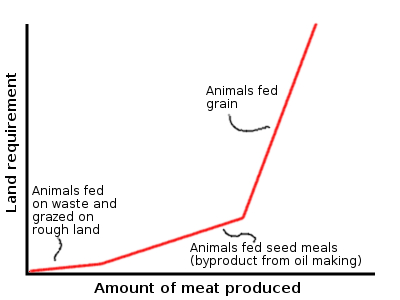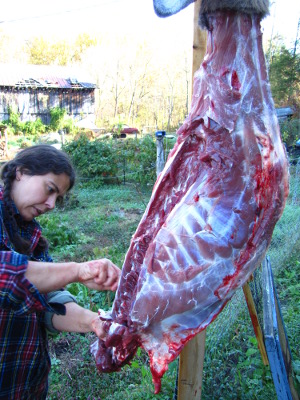
Default livestock
 What I've been leading up to
with my previous two posts is Fairlie's distinction between what he
calls "default livestock" and luxury animals. By Fairlie's
definition, default livestock are the animals we could raise primarily
on byproducts, food waste, or uncultivable land, with seed meal being a
halfway house --- it is a byproduct, but is also valuable by
itself. The chart above shows that if we stuck to default
animals, especially if we exempt seed-meal-fed animals from our
calculations, we'd be using barely any land at all to produce our meat
and dairy products. Although Fairlie doesn't come right out and
say it, I'll go out on a limb and say that at the default animal level,
it's more efficient to eat meat than not. Beyond that, meat is an
inefficient use of land.
What I've been leading up to
with my previous two posts is Fairlie's distinction between what he
calls "default livestock" and luxury animals. By Fairlie's
definition, default livestock are the animals we could raise primarily
on byproducts, food waste, or uncultivable land, with seed meal being a
halfway house --- it is a byproduct, but is also valuable by
itself. The chart above shows that if we stuck to default
animals, especially if we exempt seed-meal-fed animals from our
calculations, we'd be using barely any land at all to produce our meat
and dairy products. Although Fairlie doesn't come right out and
say it, I'll go out on a limb and say that at the default animal level,
it's more efficient to eat meat than not. Beyond that, meat is an
inefficient use of land.
 So what would your diet look
like if you only ate default livestock? Each person would get
about 40 pounds of meat per year plus about 86 pounds of milk (or 8.6
pounds of cheese). I don't keep track of how much dairy we buy,
but I figure Mark and I currently eat about 100 pounds of meat per year
apiece, over twice the default figure but less than the American
average of 166 pounds per year. Of our meat, the 76 pounds of
lamb and deer could probably count as default livestock since both
graze on non-arable land, but the 60 pounds of chicken meat is
grain-fed, as is the storebought bacon and ham we use to round out our
diet.
So what would your diet look
like if you only ate default livestock? Each person would get
about 40 pounds of meat per year plus about 86 pounds of milk (or 8.6
pounds of cheese). I don't keep track of how much dairy we buy,
but I figure Mark and I currently eat about 100 pounds of meat per year
apiece, over twice the default figure but less than the American
average of 166 pounds per year. Of our meat, the 76 pounds of
lamb and deer could probably count as default livestock since both
graze on non-arable land, but the 60 pounds of chicken meat is
grain-fed, as is the storebought bacon and ham we use to round out our
diet.
Of course, this is only
math until you start considering what default animals would really look
like on your homestead. Stay tuned for more tomorrow.
| This post is part of our Meat lunchtime series.
Read all of the entries: |
Want more in-depth information? Browse through our books.
Or explore more posts by date or by subject.
About us: Anna Hess and Mark Hamilton spent over a decade living self-sufficiently in the mountains of Virginia before moving north to start over from scratch in the foothills of Ohio. They've experimented with permaculture, no-till gardening, trailersteading, home-based microbusinesses and much more, writing about their adventures in both blogs and books.
Want to be notified when new comments are posted on this page? Click on the RSS button after you add a comment to subscribe to the comment feed, or simply check the box beside "email replies to me" while writing your comment.

The author states early in the book '"... depriving poor people of food to provide luxuries for the rich is ... 'a form of human evil' "
What malarkey! This is exactly the small minded god-complex politics I mentioned in an earlier comment.. Eating meat "while others starve" is not a human evil. Over population to the point that the local land is insufficient to support that level of humanity is not our fault, and it is not our moral imperative to feed those hungry peoples.
I will entertain arguments that eating less red meat is a life style choice that could benefit individuals. However, no one should assert that by eating as much meat as you wish you are ethically evil. Any sustainability argument needs to be geographically provincial as in, "Can we sustain this level of meat production for Americans".
I do not believe we should be exporting any food products, grains included. Grains have energy value that we under exploit. If we drove alcohol fueled cars as an alternative to importing petroleum products, that would not be a moral evil.
I am having a hard time applying Fairlie's work to my bio-region. The primary agriculture endeavor here (Osage County, OK) is free ranged beef. We have hundreds of thousands of rocky, brushy acres that are literally unsuitable for anything other than grazing cattle or goats or pumping oil. Most of the meat in my diet comes from locally grown beef bartered or bought in bulk from local ranchers. I'd definately consider them default animals since they consume uncultivated perrenial grasses from the time of weening until slaughter with the occasional suppliment.
Maybe I am biased as a carnivore but it seems like there is a whole lot of stones left unturned by his research.
Gerry --- I had trouble with that part of his argument too, but for a different reason than you, I suspect. If cutting back on my meat consumption really would let less-fortunate people have a more well-rounded diet, I'd go for it. But economics of food is so tricky that I don't think that would happen.
On the other hand, understanding how to raise your food in a smaller footprint is handy for homesteaders. The less of our land we devote to growing food, the more can stay in trees and wildlife habitat, which I do consider the greater good.
Phil --- I think that in your area, you're totally right that pastured beef would be the default meat choice. Throw in a couple of chickens to eat up any food scraps your family produces and you're all set.
Anna - Sorry to sound so acerbic. It is a character fault.
I have my own set of small minded god-complex feelings on how our food production and consumption should function. The data about how to best utilize limited resources to maximize your food production is useful. Raising a cow, beef, on your land seems infeasible to achieve near self sufficiency.
I am all for feeding more underfed Americans. If we are going to feel morally compelled to feed the billion+ famine victims and grossly malnourished women and children of the world, we should be ready to embrace flying them in to live in the neighborhood.
I think there is a lot of good information in the book, but I refuse to feel like an SS agent because I like a good cut of beef.
The graph pictured is right in principle, but the proportions & slopes are way off.
Short grass prairie or hilly land unsuitable for plowing may require 2 acres to feed a steer up to 1000lb. Tall grass prairie would only take about 1 acre to achieve that 1000 lb slaughter weight. Grain finishing the steer would add up to 400 more lb per head, but only about 50 lb of that actually makes it onto your table as meat. That grain is grown on only a fraction of an acre, but generally requires large energy & pesticide inputs.
A good scheme for the homesteader who had an acre or so of good pasture would be to buy a heifer, use AI or a neighbor's bull each year to produce a calf. Let the calf do most of the milking for you until it's weaned. You would only need the milk from a couple of milkings per week anyways to try your hand at home-made ice cream & cheeze. The calf could then be pasture kept for about 18 months at essentially no cost and slaughtered to supply you with about 400 lb of beef. (I'd say the $400 price for the local meat locker to do all the butchering work is well worth it.)
Hi Anna and all,
While it is nice to talk about how bad eating meat is, human health requires healthy fat and fat activating factors such as vitamins A, D, K1 and K2.
Also, animal derived amino acids are needed ( and not made by humans ).
So I wonder when I hear about folks who preach about vegetarian or vegan life styles. I wonder how long it will be until their reserves run out and they begin to not feel very good and to act out.
For me, find a happy and content farmer and eat what he or she eats and you too will be happy and content.
Or if you are an engineer like me, measure your hair trace minerals and do RBTI testing and adjust your diet and your soil by adding low measuring minerals so that you become happy, joyous and free
John